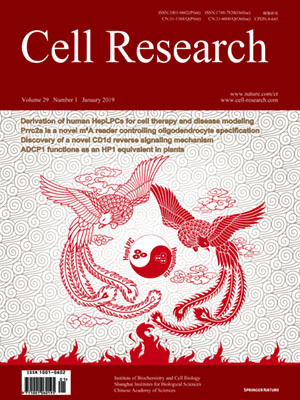Volume 29 Issue 1, January 2019: 23-41 | Open Access
ORIGINAL ARTICLES
A novel m6A reader Prrc2a controls oligodendroglial specification and myelination
Rong Wu 1, Ang Li 2,3, Baofa Sun 2,3, Jian-Guang Sun 1,3,4, Jinhua Zhang 5, Ting Zhang 2,3, Yusheng Chen 2,3, Yujie Xiao 6, Yuhao Gao 1,3,4,
Qingyang Zhang 2,3, Jun Ma 1, Xin Yang 2,3, Yajin Liao 1, Wei-Yi Lai 3,7, Xiaolong Qi 1,4, Shukun Wang 1, Yousheng Shu 6, Hai-Lin Wang 7,Fengchao Wang 8, Yun-Gui Yang 2,3,9 and Zengqiang Yuan 1,10
1The Brain Science Center, Beijing Institute of Basic Medical Sciences, 100850 Beijing, China; 2Key Laboratory of Genomic and Precision Medicine, Collaborative Innovation Center
of Genetics and Development, Beijing Institute of Genomics, Chinese Academy of Sciences, 100101 Beijing, China; 3School of Life Science, University of Chinese Academy of Sciences, 100049 Beijing, China; 4Institute of Biophysics, Chinese Academy of Sciences, 100101 Beijing, China; 5The College of Life Science and Bioengineering, Beijing Jiaotong University, Beijing, China; 6State Key Laboratory of Cognitive Neuroscience and Learning, IDG/McGovern Institute for Brain Research, School of Brain and Cognitive Sciences, the Collaborative Innovation Center for Brain Science, Beijing Normal University, 100875 Beijing, China; 7State Key Laboratory of Environmental Chemistry and Ecotoxicology,Research Center for Eco-Environmental Sciences, 100085 Beijing, China; 8National Institute of Biological Sciences, Beijing, China; 9Institute for Stem Cell and Regeneration, Chinese Academy of Sciences, 100101 Beijing, China and 10 Center of Alzheimer’s Disease, Beijing Institute for Brain Disorders, Beijing, China
Correspondence: Fengchao Wang (wangfengchao@nibs.ac.cn) or Yun-Gui Yang (ygyang@big.ac.cn) or Zengqiang Yuan (zqyuan@bmi.ac.cn, zyuan620@yahoo.com)These authors contributed equally: Rong Wu, Ang Li, Baofa Sun, Jian-Guang Sun, Jinhua Zhang, Ting Zhang.
While N6-methyladenosine (m6A), the most abundant internal modification in eukaryotic mRNA, is linked to cell differentiation and tissue development, the biological significance of m6A modification in mammalian glial development remains unknown. Here, we identify a novel m6A reader, Prrc2a (Proline rich coiled-coil 2 A), which controls oligodendrocyte specification and myelination. Nestin-Cre-mediated knockout of Prrc2a induces significant hypomyelination, decreased lifespan, as well as locomotive and cognitive defects in a mouse model. Further analyses reveal that Prrc2a is involved in oligodendrocyte progenitor cells (OPCs) proliferation and oligodendrocyte fate determination. Accordingly, oligodendroglial-lineage specific deletion of Prrc2a causes a similar phenotype of Nestin-Cre-mediated deletion. Combining transcriptome-wide RNA-seq, m6A-RIP-seq and Prrc2a RIP-seq analysis, we find that Olig2 is a critical downstream target gene of Prrc2a in oligodendrocyte development. Furthermore, Prrc2a stabilizes Olig2 mRNA through binding to a consensus GGACU motif in the Olig2 CDS (coding sequence) in an m6A-dependent manner. Interestingly, we also find that the m6A demethylase, Fto, erases the m6A modification of Olig2 mRNA and promotes its degradation. Together, our results indicate that Prrc2a plays an important role in oligodendrocyte specification through functioning as a novel m6A reader. These findings suggest a new avenue for the development of therapeutic strategies for hypomyelination-related neurological diseases.
https://doi.org/10.1038/s41422-018-0113-8
FULL TEXT | PDF
Browse 1313


